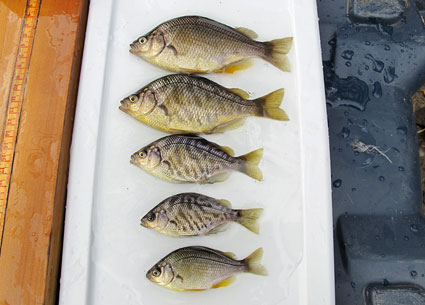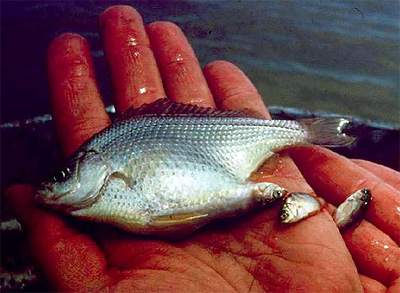BTW, the IUCN has evaluated this species several times. The last time being 2013 where the tule perch was listed as 'least concern' in its conservation status:
Taxonomy
Kingdom Phylum Class Order Family
ANIMALIA CHORDATA ACTINOPTERYGII PERCIFORMES EMBIOTOCIDAE
Scientific Name: Hysterocarpus traskii
Species Authority: Gibbons, 1854
Common Name(s):
English – Tule Perch
Synonym(s): Hysterocarpus traski Gibbons, 1854 [orth. error]
Assessment Information
Red List Category & Criteria: Least Concern
ver 3.1
Year Published: 2013
Date Assessed: 2012-02-17
Assessor(s): NatureServe
Reviewer(s): Smith, K. & Darwall, W.R.T.
Facilitator/Compiler(s): Hammerson, G.A. & Ormes, M.
Justification:
Distribution and abundance have declined over the long term, but the species is listed as Least Concern because the extent of occurrence, area of occupancy, number of locations, and population size are still quite large, and the species probably is not declining fast enough to qualify for any of the threatened categories.
Geographic Range
Range Description: Range includes Clear Lake; and the Russian, Sacramento-San Joaquin, and Pajaro-Salinas river drainages, California (Moyle 2002, Page and Burr 2011). Non-native populations are established in some areas, including Silverwood and Pyramid reservoirs in southern California (Moyle 2002).
Countries:
Native:
United States
Population
Population: This species is represented by a fairly large number of occurrences (subpopulations).
Total adult population size is unknown but apparently quite large (likely greater than 100,000). This species is still abundant in portions of its range (Moyle 1976, 2002).
Abundance is greatly reduced from historical levels (Moyle 1976, 2002), particularly in the Pajaro-Salinas and San Joaquin river drainages. The species is still common in Clear Lake, but (considering changes in land and shore use and expected new introductions of alien species) its future there is by no means secure (Moyle 2002). Abundance in the Russian River apparently declined between the early 1970s and late 1980s (Moyle 2002).
Trend over the past 10 years or three generations is uncertain but probably relatively stable or slowly declining.
Population Trend: Stable
Habitat and Ecology
Habitat and Ecology: Habitat includes small to large, low-elevation rivers; a large lake; and estuarine sloughs. This species is found in a wide variety of habitats, including slow or swift-flowing water where conditions are clear or turbid, but usually it occurs in cool, well-oxygenated water with emergent aquatic vegetation, deep pools, and banks with complex cover (Moyle 1976, 2002).
Systems: Freshwater
Threats
Major Threat(s): Decline is apparently due primarily to habitat alterations (Moyle 1976, 2002). This species' viviparity seems to reduce its vulnerability to competition and predation from alien fishes, yet non-native fish species pose a continual potential threat (Moyle 2002). Decline in the Pajaro-Salinas and San Joaquin river drainages may have resulted from poor water quality and toxic chemicals (Moyle 2002). An apparent long-term decline in the San Francisco Estuary possibly is related to increased populations of centrarchids (Moyle 2002). Decline in the Russian River is probably related to habitat alteration caused by dams and decreased water quality from agricultural development; the latter also increases the potential for pesticide spills and other disasters (Moyle 2002).
This species seems to be able to persist in small numbers as long as suitable cover and water quality are present (Moyle 2002).
Conservation Actions
Conservation Actions: Currently, this species is of relatively low conservation concern and does not require significant additional protection or major management, monitoring, or research action.
Citation: NatureServe 2013.
Hysterocarpus traskii. The IUCN Red List of Threatened Species. Version 2015.2. <
www.iucnredlist.org>. Downloaded on
28 July 2015.










